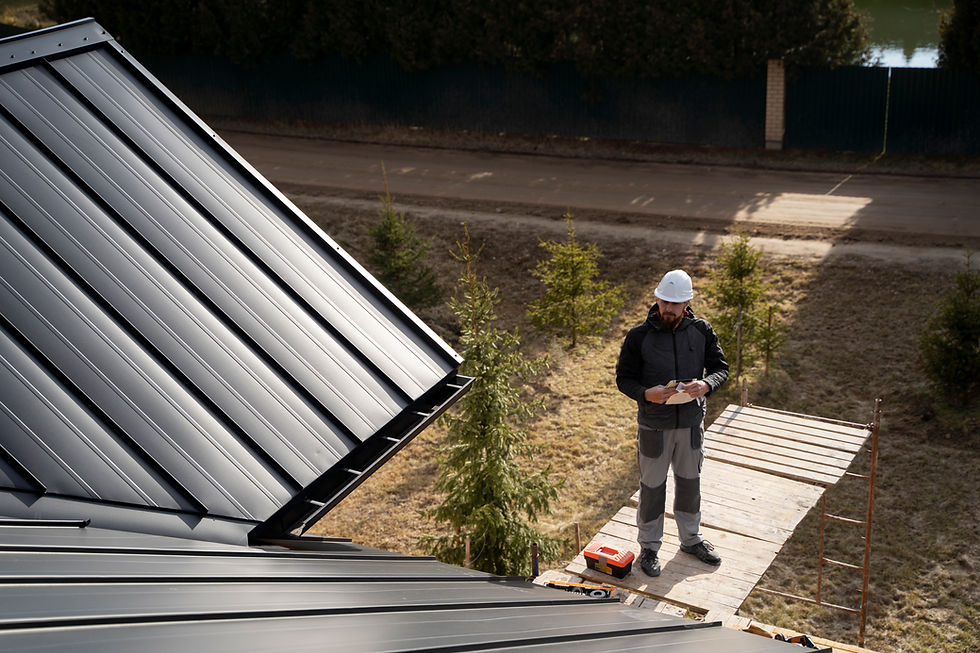Can DIY Roof Repairs Be as Effective as Professional Services?
- John Shaw
- Mar 26
- 4 min read
Roof repairs are an essential aspect of home maintenance, ensuring the safety and longevity of your property. Whether it’s a minor leak or significant damage, many homeowners find themselves debating whether to handle the repairs themselves or call in a professional. While DIY roof repairs may seem like a cost-effective solution, they come with challenges and risks. On the other hand, professional services provide expertise and quality assurance but at a higher cost. This article explores whether DIY roof repairs can be as effective as professional services, with a focus on Roof Repairs, Flat Roofing, Fascias and Soffits.
Understanding the Scope of Roof Repairs
Before deciding whether to tackle roof repairs yourself, it’s essential to understand the complexity of the job. Some repairs, such as replacing a few shingles or sealing a minor leak, may be manageable for a skilled DIY enthusiast. However, more extensive repairs involving flat roofing, fascias and soffits, or structural damage often require professional expertise. Evaluating the extent of the problem is the first step in making an informed decision.
Advantages of DIY Roof Repairs
1. Cost Savings
One of the primary reasons homeowners opt for DIY roof repairs is to save money. Professional roofing services can be expensive, and by handling the repairs yourself, you can avoid labour costs. If you already have the necessary tools, the savings can be even greater.
2. Immediate Action
When dealing with minor roofing issues, waiting for a professional appointment can sometimes make the problem worse. DIY repairs allow you to address the issue immediately, preventing further damage and potentially saving money in the long run.
3. Learning a New Skill
For those who enjoy hands-on work, roof repairs can be a valuable learning experience. Understanding the basics of roof repairs, flat roofing, fascias and soffits can help you identify issues early and perform minor maintenance, reducing the need for professional intervention.
4. Customisation and Control
When handling your own roof repairs, you have complete control over the materials and techniques used. This can be particularly beneficial if you have specific preferences or need to match existing roofing materials.

Risks and Challenges of DIY Roof Repairs
1. Safety Concerns
Working at height presents significant risks, especially for those without experience. Falls from ladders or unstable roofs can lead to severe injuries. Professional roofers are trained in safety protocols and equipped with harnesses, scaffolding, and other protective gear to minimise risks.
2. Lack of Expertise
Roofing requires specific skills and knowledge. Mistakes made during DIY repairs can lead to further damage, leaks, or even structural issues. Improperly installed materials can compromise the integrity of your roof, leading to costly future repairs.
3. Time-Consuming Process
Even minor roof repairs can be time-consuming, especially for those unfamiliar with roofing techniques. What may seem like a quick fix could turn into a weekend-long project, delaying other responsibilities and potentially exposing your home to further damage.
4. Limited Warranty and Insurance Coverage
Most professional roofing services provide warranties on their work, giving homeowners peace of mind. DIY repairs, however, do not come with such guarantees. Additionally, if an issue arises due to improper DIY work, insurance claims may be denied, leaving you to cover the costs out of pocket.
Benefits of Hiring Professional Roofers
1. Expertise and Quality Workmanship
Professional roofers have years of experience dealing with all types of roof repairs, including flat roofing, fascias and soffits. Their expertise ensures the job is done correctly, reducing the risk of future problems.
2. Access to High-Quality Materials
Roofing companies often have access to better materials at trade prices, ensuring durability and longevity. Using subpar materials in DIY repairs can result in recurring issues, negating any initial cost savings.
3. Time Efficiency
Professional roofers can complete repairs much faster than the average homeowner. What might take a DIYer several days can be completed by a professional in a matter of hours, reducing the risk of exposure to the elements.
4. Compliance with Building Regulations
Certain roof repairs, particularly those involving structural changes, must comply with local building regulations. Professional roofers understand these requirements and ensure all work is completed to standard, preventing legal issues in the future.
5. Safety Assurance
Professional roofers are trained in proper safety procedures, significantly reducing the risk of accidents. They also carry insurance, meaning any damage or injuries sustained during the job are covered, providing homeowners with added protection.
When DIY Roof Repairs Might Be Suitable
While hiring a professional is often the best option, there are instances where DIY repairs might be a reasonable choice:
Minor shingle replacement – If only a few shingles are missing or damaged, replacing them can be relatively straightforward.
Clearing debris and gutters – Keeping gutters clear of leaves and debris can help prevent roof damage and is safe for most homeowners to do.
Small leak sealing – Using roof sealant to fix a minor leak can be a temporary solution while waiting for professional repairs.
Fascia and soffit painting or minor repairs – If the damage is minimal, homeowners with carpentry skills may be able to handle these tasks themselves.
Conclusion: DIY vs. Professional Roof Repairs – Which Is Better?
While DIY roof repairs can save money and be a rewarding experience, they come with significant risks and limitations. For small, manageable tasks, a confident DIYer may be able to make effective repairs. However, for extensive damage, flat roofing, or work involving fascias and soffits, hiring a professional is the safest and most reliable option.



Comments